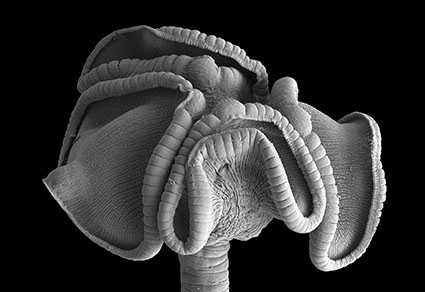New tapeworm species named after the PI
A new tapeworm species was named after Dr. Denis Jacob Machado

A new article entitled “Diversity and phylogenetic position of the amphi-American lineages of the tapeworms of the genus Anthocephalum Linton, 1890 (Rhinebothriidea: Anthocephaliidae)” was published on the journal Zootaxa (DOI: 10.11646/zootaxa.5584.2.1). The article was authored by Lilian F. Sakai, Fernando Portella de Luna Marques, and Bruna Trevisan, from the University of São Paulo (Brazil).
This paper explores the diversity, evolutionary history, and classification of a group of tapeworms belonging to the family Anthocephaliidae, with a focus on the genus Anthocephalum. Tapeworms are parasitic flatworms that live inside the intestines of fish and other animals. Despite recent research, many details about their classification and evolution remain unclear.
To better understand these tapeworms, the researchers analyzed DNA from 15 specimens collected from different locations, including Brazil, Panama, and Senegal. Using genetic sequencing and advanced computational techniques, they reconstructed the evolutionary relationships between different species. Their findings confirmed that Anthocephaliidae is a valid group, but they also revealed inconsistencies within its classification. Specifically, they discovered that the genus Alveobothrium, previously considered separate, should actually be merged into Anthocephalum. This revision increases the number of recognized Anthocephalum species to 30.
Additionally, the researchers found four new lineages of Anthocephalum, indicating that many more species might exist in unexplored regions or hosts. Their biogeographical analysis suggests that these tapeworms likely originated in the Central Indo-Pacific region and then spread to different areas over time.
Why is this important?
- Refines the classification of tapeworms, ensuring species are properly named and grouped.
- Expands knowledge of tapeworm diversity, highlighting undiscovered species.
- Provides insights into their evolutionary history, showing how they spread across different regions.
- Aids in future studies by suggesting better methods for analyzing tapeworm evolution.
What species was named after Denis?
Anthocephalum machadoi is a newly described species of tapeworm belonging to the family Anthocephaliidae within the order Rhinebothriidea. It was discovered in the spiral intestine of the longnose stingray (Hypanus guttatus), which serves as its type host. The species was primarily identified along the coast of Maceió, Alagoas, Brazil, with additional specimens found in Colares, Pará, Brazil.
Compared to other species in Anthocephalum, A. machadoi is unique in its combination of size, loculi count, and reproductive organ arrangement:
- It has more marginal loculi than A. blairi, A. gravisi, A. haroldsoni, and A. papefayei, but fewer than A. gracile, A. healyae, A. lukei, A. meadowsi, and others.
- The number of testes (35–46) is distinct from related species such as A. decrisantisorum, A. jensenae, and A. ruhnkei, which have significantly fewer or more testes
The etymology of A. machadoi reads: “This species honors Dr. Denis Jacob Machado for his contribution to the systematics of cestodes through his expertise in bioinformatics.”
The identification of A. machadoi highlights the underexplored diversity of parasitic tapeworms in stingrays, emphasizing the need for further taxonomic and biogeographical studies. This discovery also contributes to the ongoing revision of Anthocephalum taxonomy and its evolutionary relationships.
Previous post
New Grant Funded on Viral Recombination Detection
Next post
Unveiling Hidden Patterns in Tapeworm Evolution with Machine Learning
